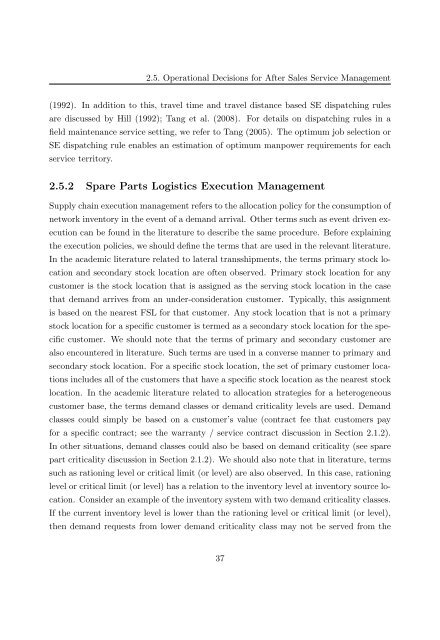Customer Information Driven After Sales Service ... - RePub
Customer Information Driven After Sales Service ... - RePub
Customer Information Driven After Sales Service ... - RePub
You also want an ePaper? Increase the reach of your titles
YUMPU automatically turns print PDFs into web optimized ePapers that Google loves.
2.5. Operational Decisions for <strong>After</strong> <strong>Sales</strong> <strong>Service</strong> Management<br />
(1992). In addition to this, travel time and travel distance based SE dispatching rules<br />
are discussed by Hill (1992); Tang et al. (2008). For details on dispatching rules in a<br />
field maintenance service setting, we refer to Tang (2005). The optimum job selection or<br />
SE dispatching rule enables an estimation of optimum manpower requirements for each<br />
service territory.<br />
2.5.2 Spare Parts Logistics Execution Management<br />
Supply chain execution management refers to the allocation policy for the consumption of<br />
network inventory in the event of a demand arrival. Other terms such as event driven execution<br />
can be found in the literature to describe the same procedure. Before explaining<br />
the execution policies, we should define the terms that are used in the relevant literature.<br />
In the academic literature related to lateral transshipments, the terms primary stock location<br />
and secondary stock location are often observed. Primary stock location for any<br />
customer is the stock location that is assigned as the serving stock location in the case<br />
that demand arrives from an under-consideration customer. Typically, this assignment<br />
is based on the nearest FSL for that customer. Any stock location that is not a primary<br />
stock location for a specific customer is termed as a secondary stock location for the specific<br />
customer. We should note that the terms of primary and secondary customer are<br />
also encountered in literature. Such terms are used in a converse manner to primary and<br />
secondary stock location. For a specific stock location, the set of primary customer locations<br />
includes all of the customers that have a specific stock location as the nearest stock<br />
location. In the academic literature related to allocation strategies for a heterogeneous<br />
customer base, the terms demand classes or demand criticality levels are used. Demand<br />
classes could simply be based on a customer’s value (contract fee that customers pay<br />
for a specific contract; see the warranty / service contract discussion in Section 2.1.2).<br />
In other situations, demand classes could also be based on demand criticality (see spare<br />
part criticality discussion in Section 2.1.2). We should also note that in literature, terms<br />
such as rationing level or critical limit (or level) are also observed. In this case, rationing<br />
level or critical limit (or level) has a relation to the inventory level at inventory source location.<br />
Consider an example of the inventory system with two demand criticality classes.<br />
If the current inventory level is lower than the rationing level or critical limit (or level),<br />
then demand requests from lower demand criticality class may not be served from the<br />
37

















